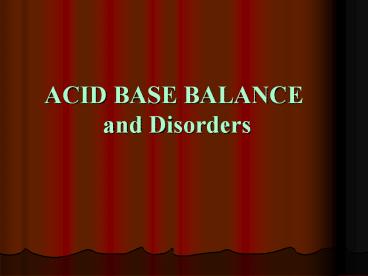ACID BASE BALANCE and Disorders - PowerPoint PPT Presentation
Title:
ACID BASE BALANCE and Disorders
Description:
ACID BASE BALANCE and Disorders Acids : Are any substance which tends to release H+ in water , either by simple dissociation or reaction The strength of acids is ... – PowerPoint PPT presentation
Number of Views:205
Avg rating:3.0/5.0
Title: ACID BASE BALANCE and Disorders
1
ACID BASE BALANCE and Disorders
2
Acids
- Are any substance which tends to release H in
water , either by simple dissociation or reaction - The strength of acids is measured by the extent
to which it liberate H but not by the number of
H in the acid molecule e.g. phosph . a. and
carbonic a . are weaker than HCL ( the later is
completely dissociated ). - The acidity of the solution is determined by H-
expressed in gm ion/l. ( or nmol/l.).
3
Bases
- Are substances which tends to accept H, since
the anion liberated along with H when acid
dissociated were bases e.g. Cl in HCL, NH3 in
NH4 - The strong base is that substance with high
tendency to accept H e.g. anion of weakly
dissociated acid e.g H2CO3
4
Aprote
- Metallic cation e.g Na , K which are not bases
or acids
5
HYDROGEION HOMEOSTASIS
- The buffer
- It is the substance which resists change in its
PH, when excess acid or base is added - Usually are weak acids and its salts e.g. H2CO3
6
- Addition of acids ? dissociation of the weak
acid or its salt e.g. H2CO3 ( H , HCO3 0 slowely
and the anion neutralize any excess acid ( H)
e.g HCL NaHCO3 ? NACl H2CO3. ( weak acid is
formed instead of strong one ). - Addition of bases ? dissociation of the weak acid
H HCO3 , H neutralize the base added without
great change in PH.
7
?pH?
- It is log10 Log10 of the
- reciprocal of (H)
- The Log10 of a number is the power to which 10
must be raised to produce this number e.g log10
102 if log10 to "x" number 7 so the number
must be 107 - At pH6 (H) ??
1 H
8
- pH Log10 Log10 (H) 6
- ( H) 10-6 0.000001 mol 1000nmol/L
- at pH7 , (H) will be 100 nmol/L so each one unit
change in pH mean 10 folds change in (H)
1 H
9
Blood Buffer systems
- Bicarbonate / Carbonic acid
- The most important buffer of plasma
- It presents in RBCs , but in lesser concentration
10
HANDERSON HASSELBALCH equation
dissoeiation
hydration
- CO2 H2O H2CO3
- H HCO3
- K hydration
- H2CO3 ? H HCO3
H2CO3 CO2xH2O
11
- K dissociation
- K combined x
- H2O is constant and so K ? K
H x HCO3 H2CO3
H2CO3 CO2xH2O
H xHCO3 H2CO3
H x HCO3 CO2xH2O
12
- K
- ( H) K x
- pH Log10 Log log
- pK Log
H x HCO3 dCO2
dCO2 HCO3
1 (H)
1 K
HCO3 dCO2
HCO3 0.03xPCO2
13
Note
- ( dissociation constant of CO2 0.03)
- ( PK. For BiC. / Carb. Buffer system 6.1)
14
2) Phosphate buffer -
- Inorganic phosphate accounts for 5 of the
nonbicarbonate buffer value, at a plasma Ph of
7.4 , the ratio HPO4/H2PO4 is 80/20 ( 4/1)
(PK6.8)
15
- Organic phosphate in the RBCs in the form pf
2.3-diphosphoglycerate accounts for 16 of the
non bicarbonate buffer. - H2PO4OH HPO4 H2O
- HpO4 H H2Po4
16
Plasma protein buffer- 3)
- Albumin form 95 of the non bicarbonate buffer
value of the plasma - The most important buffer groups of proteins are
the imidazole group of histidine ( 16 in each
albumin molecule)
17
Hemoglobin buffer
- Account for 84 of the RBCs non bic buffer the
most important buffer groups are imidazole groups
of Hb. Histidine
18
- Carbamino Compoands
- Combination of small amount of CO2 in RBCs with
Hb.R NH2 Co2 R NH COO H
19
Regulation of (H)
- Dilution
- Buffer system ? Plasma
- HCO3/H2CO3 (201)
- B2HPO4 / BH2PO4 ( 41)
- Prot. /prot.H(95 of the non bic
20
- RBCs
- HbO2 / HHb ( 84 of the non bicarb.)
- Carbamino compounds
- HCO3 /H2CO3 ( to less extent)
- 2.3 diph. glye.16of the non bic.
21
- 3 . Respiratory Mechanism C.R.C. ( Central
chem.., Periph. Chem.) - 4 . Renal Mechanism
- Acid excrction
- Na -H exchange
- Ammonia formation and NH4 excretion
- H2PO4 excretion
- HCO3 reclamation































